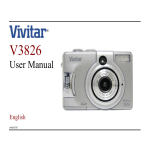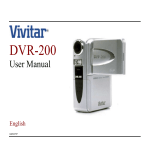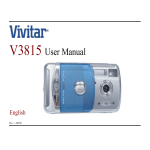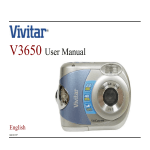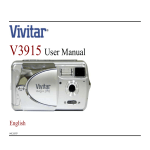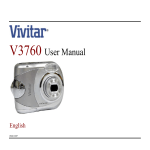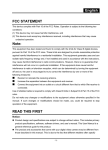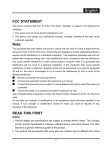Download Vivitar ViviCam 3935 Digital Camera
Transcript
Vivicam 3935 User Manual
English
040507TP
FCC STATEMENT
This device complies with Part 15 of the FCC Rules. Operation is subject to the following two
conditions:
1. This device may not cause harmful interference, and
2. This device must accept any interference received, including interference that may cause
undesired operation
Note:
This equipment has been tested and found to comply with the limits for Class B digital
devices, pursuant to Part 15 of the FCC rules. These limits are designed to provide
reasonable protection against harmful interference in a residential installation. This
equipment generates, uses and can radiate radio frequency energy and, if not installed and
used in accordance with the instructions, may cause harmful interference to radio
communications. However,there is no guarantee that interference will not occur in a
particular installation. If this equipment does cause harmful interference to radio or television
reception, which can be determined by turning the equipment off and on, the user is
encouraged to try to correct the interference by one or more of the following measures:
Reorient or relocate the receiving antenna.
Increase the separation between the equipment and receiver.
Connect the equipment into an outlet on a circuit different from that to which the receiver
is connected.
Consult the dealer or an experienced radio/TV technician for help.
1
E
Use of shielded cable is required to comply with Class B limits in Subpart B of Part 15 of the
FCC rules.
Do not make any changes or modifications to the equipment unless otherwise
specified in the manual. If such changes or modifications should be made,
you could be required to stop operation of the equipment.
E
2
TRADEMARK INFORMATION
Microsoft® and Windows® are U.S. registered trademarks of Microsoft Corporation.
Pentium® is a registered trademark of Intel Corporation.
Macintosh is a trademark of Apple Computer, Inc.
SDTM is a trademark.
PhotoSuite, PhotoVista are trademarks.
Other names and products may be trademarks or registered trademarks of their respective
owners.
READ THIS FIRST
Please start by reading the important messages below first.
1. The bundled driver, software, design, specifications and user's manual that were packaged
with the camera are subject to change without notice.
2. The accessories that come with the ViviCam 3935 may vary between regions.
3. For driver updates, refer to our website or contact your dealer.
4. We are not liable whatsoever for any compensation arising from errors in descriptions in
this user's manual.
3
E
WARNINGS
Do not use the camera if it is emitting smoke, unusual odor or noise, becoming unusually
hot to be touched, or if it is in any other abnormal state. Operating the camera in any of these
circumstances may cause a fire or an electrical shock. Stop using the camera immediately,
turn the camera off, and then disconnect the power source (batteries or AC power adapter).
(If you are using the AC power adapter from the AC power outlet after you have disconnected
the camera.) After checking that smoke is no longer being emitted, contact your dealer or
authorized service facility for repairs.Never attempt to repair this camera by yourself, as this
is dangerous.
E
Do not use the camera if any foreign objects have entered the camera. Turn the camera off,
remove the batteries, and then disconnect the power source (batteries or an AC power
adapter.) (If you are using the AC power adapter, unplug the adapter from the AC power
outlet after you have disconnected the camera.) Later on contact your dealer or authorized
service facility. Do not continue to use the camera as this may cause a fire or an electrical
shock.
Do not place the camera in any unstable locations such as on a wobbly table or slopping
surface where the camera may fall or tip over and cause damage.
4
If the camera has been dropped or if the camera case has been damaged, turn the camera
off, and then disconnect the power source (batteries or AC power adapter.) (If you are using
the AC power adapter, unplug the adapter form the AC power outlet after you have
disconnected the camera.) Then contact to your dealer or authorized service facility. Do not
continue to use the camera as this may cause a fire or an electrical shock.
Do not expose the camera to moisture and avoid water gets into the camera. Take particular
care when using the camera under extreme weather conditions, such as rain or snow, or
when operating the camera at the beach or near water. Water in the camera may cause a
fire or an electrical shock.
Do not touch the power plug during a thunderstorm if you are using the AC power adapter.
This may cause an electrical shock.
Do not attempt to modify the camera. This may cause a fire or an electrical shock.
Do not remove the camera casing. This may cause an electrical shock. Internal inspection,
maintenance and repairs should only be carried out by our authorized service facility.
Do not touch the power plug during a thunderstorm if you are using the AC power adapter.
This may cause an electrical shock.
5
E
CAUTIONS
Do not place the camera in damp or dusty locations. This may cause a fire or an electrical
shock.
Do not place the camera in a location affected by oil fumes or steam, such as near a
cooking stove or humidifier. This may cause a fire or an electrical shock.
E
Do not cover or wrap the camera or the AC power adapter with a cloth or quilt. This may
cause heat to build up, distort the case and cause a fire. Always use the camera and its
accessories in well-ventilated locations.
Handle the camera carefully and do not bump the camera into any hard object. Handling the
camera roughly may cause a malfunction.
Do not move the camera while it is switched on. (If you are using the AC power adapter,
unplug the adapter from the AC power outlet after you have switched off the camera.)
Ensure that any connector cords or cables to other devices are disconnected before moving
the camera. Failure to do so may damage the cords or cables and cause a fire or an
electrical shock.
6
When leaving the camera unused for long periods, such as during a vacation, always
unplug the camera from the power source (batteries or AC power adapter) for safety. (If you
are using the AC power adapter, unplug the adapter from the AC power outlet after you have
disconnected the camera.) Failure to do so could result in a fire.
Do not use batteries other than those specified for use with the camera. The use of unsuitable
batteries may result in the batteries splitting or leaking and causing a fire, injury, or soiling
of the battery compartment.
When fitting batteries into the camera, check the polarity markings on the battery (- and +) to
ensure that you insert the battery correctly. Incorrect battery polarity may result in the batteries
splitting or leaking and causing a fire, injury, or soiling of the battery compartment.
Remove the batteries if the camera will not be used for an extended period of time. The
batteries may leak and cause a fire, injury or soiling of the battery compartment. If the
batteries leak, clean and wipe the battery compartment carefully and install new batteries.
Wash your hands carefully if you touch the battery fluid.
WARNING: Handling the USB and AV cables on this product may expose you to lead, a
chemical known to the State of California to cause birth defects or other reproductive harm.
Wash hands after handling.
7
E
CONTENTS
INTRODUCTION ......................................................................................... 12
Overview .......................................................................................................... 12
E
Package Contents ........................................................................................... 13
GETTING TO KNOW YOUR VIVICAM 3935 ................................................ 14
Front View ...................................................................................................... 14
Rear View ....................................................................................................... 15
Mode Dial ........................................................................................................ 16
LED Indicators ................................................................................................. 17
LCD Monitor Information .................................................................................. 18
GETTING STARTED .................................................................................. 21
Installing the Batteries .................................................................................... 21
Using an AC Power Adapter (Optional Accessory) .......................................... 22
Loading an SD Memory Card (Optional Accessory) ......................................... 23
Attaching the Camera Strap ............................................................................. 24
8
Attaching the Lens Strap..............................................................................24
Choosing the OSD Language ........................................................................... 25
Setting the Date and the Time ......................................................................... 26
Setting the Image Resolution and Quality ........................................................ 27
CAPTURING IMAGES......................................................................................29
Basic Settings ................................................................................................. 29
Viewfinder ........................................................................................................... 29
LCD Monitor ........................................................................................................ 30
Zoom Functions ................................................................................................. 31
Self-Timer ........................................................................................................... 32
Flash ................................................................................................................... 33
Photography Modes ........................................................................................ 35
Manual Mode ...................................................................................................... 36
Aperture Priority........................................................................................................37
Shutter Speed Priority...............................................................................................37
Automatic Mode ..................................................................................................
Macro Mode ........................................................................................................
Portrait Mode ......................................................................................................
Landscape Mode ................................................................................................
38
39
40
41
9
E
Night Scene Mode .............................................................................................. 42
Sports Mode ....................................................................................................... 43
PLAYBACK MODE ...................................................................................... 44
Viewing Images ............................................................................................... 45
Zoom Playback ............................................................................................... 46
Displaying Thumbnail Images .......................................................................... 47
Slide Show Display ......................................................................................... 48
E
Deleting Images/Video Clips ........................................................................... 49
Delete One Image/Video Clip at a Time ........................................................... 49
Delete All Images/Video Clips at Once ............................................................. 50
Formatting an SD card or Internal Memory.....................................................51
Protecting Images/ Video Clips....................................................................52
MOVIE MODE ............................................................................................. 53
Recording Video Clips ..................................................................................... 53
Viewing Video Clips ........................................................................................ 54
TRANSFERRING IMAGES AND VIDEO CLIPS TO YOUR COMPUTER ...... 55
Step 1: Installing the USB Driver on a Windows PC ......................................... 56
Installing the USB Driver on a Macintosh Computer.......................................56
10
Step 2: Connecting the ViviCam 3935 to Your Computer ................................. 57
Step 3: Downloading Images/Video Clips ........................................................ 58
For Computers Running Windows .................................................................... 58
For Computers Running Mac OS ....................................................................... 58
INSTALLING PHOTOSUITE ....................................................................... 59
INSTALLING PHOTOVISTA ........................................................................ 60
INSTALLING ACROBAT READER..................................................................61
USER’S MANUAL ON CD-ROM......................................................................62
MENU OPTIONS ......................................................................................... 63
Capture Menu .................................................................................................. 63
Playback Menu ............................................................................................... 70
Setup Menu .................................................................................................... 72
CONNECTING THE VIVICAM 3935 TO OTHER DEVICES ......................... 75
VIVICAM 3935 SPECIFICATIONS ................................................................ 76
11
E
INTRODUCTION
Overview
E
Your new ViviCam 3935 delivers high quality, 2560 x 1920 resolution images using a 5.0
Megapixel CCD sensor. Using either the optical viewfinder or the color TFT image LCD display,
you can compose images and then examine them in detail. An auto-flash sensor automatically
detects the shooting (lighting) conditions and determines whether the flash should be used.
This feature helps ensure that your images turn out right.
Secure Digital (SD) Memory Cards store images that you have captured. Even if the ViviCam
3935's power is turned OFF, the images saved on the SD Memory Card are not erased. SD
Memory Card can be repeatedly read and written.
In addition to still images, you can record short videos using the movie function. Images you
have captured can be downloaded to your computer using the USB cable (A USB driver is
required for Win 98) You can enhance and retouch your images on your computer by using the
provided editing software, or image editing software you may already own. You may share
your images with your friends via e-mail, in a report, or on a website.
12
Package Contents
Carefully unpack your kit box and ensure that you have the following items. In the event that any
item is missing or if you find any mismatch or damage, promptly contact your dealer.
Digital Camera
USB Cable
User's Manual
Video Cable
Camera Pouch
Lens Strap
Software CD-ROM
2 x AA Alkaline Batteries
E
Camera Strap
Common (Optional) Accessories:
SD Memory Card
AC Power Adapter
The accessories that come with your ViviCam 3935 may be different from those described in this manual due to the fact
that different retailers often specify slightly different product inclusions and accessories to suit their market requirements,
customer demographics, and geographical preferences. Products very often vary between retailers especially with
accessories such as batteries, chargers, AC adapters, memory cards, cables, carrying cases/pouches, and language
support. Occasionally a retailer will specify a unique product color, appearance, and internal memory capacity. Contact
your dealer for precise product definition and included accessories.
13
GETTING TO KNOW YOUR VIVICAM 3935
Front View
E
1.
2.
3.
4.
5.
6.
14
Mode dial/movie record button
Shutter button
Camera strap/ lens strap lug
A/V OUT (Audio/Video Out) terminal
USB port
DC-in connector
7. Power switch
8. Flash
9. Viewfinder window
10. Lens
11. Self-timer LED
12. Microphone
Rear View
1.
2.
3.
4.
5.
Arrow button (Up)
Flash button
Arrow button (Right)
Arrow button (Down)
Self-timer button
Arrow button (Left)
OK OK button(Display On/Off)
E
1.
2.
Viewfinder
LED indicator
3.
4.
LCD monitor
Delete button
5.
Tripod socket
6. T Optical Zoom (Telephoto)
Digital zoom button
W Optical Zoom (Wide)
Thumbnail button
7.
8.
Playback button
Menu button
9.
Battery/SD card cover
15
Mode Dial
E
1.
M
2.
3.
4.
A
Mode
Manual Mode
Automatic Mode
Macro Mode
Portrait Mode
5.
Landscape Mode
6.
Night Scene Mode
7.
8.
9.
Sports Mode
Setup Mode
Movie Mode
16
Description
This manual mode lets you adjust additional image
settings (Color, Saturation, Sharpness)
Select this mode for "point-and-shoot" action.
Select this mode to shoot a close-up of a subject.
Select this mode to make people stand out with the
background out-of-focus.
This mode is used when the distance to the subject is
greater than 6 feet.
Select this mode to capture images of people against a
dark or night-time background.
Select this mode to capture fast-moving subjects.
Select this mode to adjust the camera settings.
Select this mode to record video (movie) clips.
LED Indicators
Indicator
LED indicator
LED indicator
LED indicator
LED indicator
LED indicator
LED indicator
LED indicator
Status
Solid red
Solid green
Blinking red
Blinking red
Blinking green
Blinking green
Solid green
Description/Activity
The ViviCam 3935 is powering up
The ViviCam 3935 is powered and ready
Camera error
The flash is Charging
Image is being recorded to the memory card
USB communication/transfer in progress
The ViviCam 3935 is ready to record images
(or movies)
Self-timer indicator Blinking red The self-timer function is activated
------Error message
------Valid button event
(1) The camera sounds one beep.
(3) The camera sounds three beeps.
Sound
No
Yes *(1)
Yes *(3)
No
No
No
Yes *(1)
E
Yes *(1)
Yes *(3)
Yes *(1)
17
LCD Monitor Information
These indicators are displayed when recording still images
E
1. Scene mode
[M] Manual mode
3. Image quality
[
] Fine
[A] Automatic mode
[
] Normal
[
] Economy
[
[
[
[
[
]Macro mode
]Portrait mode
]Landscape mode
]Night Scene mode
]Sports mode
2. Image size (resolution)
[ ]2560 x 1920 pixels
[ ]1600 x 1200 pixels
[ ]1280 x 960 pixels
[ ]640 x 480 pixels
18
4. Saturation
[ ] High
[ ] Medium
[ ] Low
5. Sharpness
[ ] High
[ ] Medium
[ ] Low
6. White balance
Automatic
[ ] Daylight
[ ] Cloudy
[ ] Sunset
[
[
] Tungsten
] Fluorescent
7. ISO
Automatic
100
200
400
9. Color
[
] Full color
[
] Black & White
] Sepia
[
10. Card indicator
E
11. Remaining images
12. [
[
[
[
] Adapter indicator
Battery level
] Full battery power
] Medium battery power
] Virtually no battery power
13. EV compensation
8. Flash mode
[ ] Fill flash (on)
[ ] Flash off
[ ] Automatic flash
[ ] Automatic with Red-eye reduction
19
These indicators are displayed when recording video clips:
1. Movie mode
2. Recording indicator
3. Video counter
4. Battery level/ Adapter indicator
5. Card indicator.
E
These indicators are displayed when playing images back:
1. Reverse arrow
2. Card indicator
3. Forward arrow
4. Current image/ total number of images
5. Battery level/ Adapter indicator
These indicators are displayed when playing video clips back:
1. Reverse arrow
2. Battery level/ Adapter indicator
3. Card indicator
4. Forward arrow
5. Current image/ total number of images
6. Movie mode
7. Recorded time
20
3
4
1
2
5
7
6
GETTING STARTED
You can use 2 AA size batteries (Alkaline or Ni-MH), one CR-V3, or an AC power adapter (3.0V/
2.5A) to power the ViviCam 3935. Battery power is convenient for capturing images or recording
video clips while an AC power adapter is useful when transferring images to your computer.
Installing the Batteries
E
1. Make sure the camera is off.
2. Slide the battery/SD memory card cover.
3. Insert the batteries, noting correct polarity (+ and -).
4. Close the battery/SD memory card cover firmly.
If you won't be using the batteries for an extended period of time, remove them from the camera to prevent the
leakage or corrosion.
Never use manganese batteries.
Avoid using the batteries in extremely cold environments as low temperatures may shorten the battery life and reduce
the camera performance.
21
Using an AC Power Adapter (Optional Accessory)
1. Make sure the camera is turned off.
2. Open the ports cover and connect one end of the AC power
adapter to the jack labeled "DC IN".
3. Connect the other end to an electrical outlet.
E
Make sure to use only the AC power adapter specified for the camera. Damage caused by the use of an incorrect
adapter is not covered under the warranty.
To prevent unexpected auto power off resulting from no battery power left during the process of transferring your
images to the computer, use the AC power adapter as a power supply.
22
Loading an SD Memory Card (Optional Accessory)
The ViviCam 3935 comes with internal memory, allowing you to store images and video clips
in the camera. However, you can expand the memory capacity by using an SD memory card so
that you can store additional images and video clips.
1. Make sure the camera is turned off.
2. Slide the battery/SD memory card cover .
3. Insert an SD memory card.
If the card cannot be inserted, check the orientation.
4. Close the battery/SD card cover.
To remove the SD memory card, make sure the camera
is off. Open the battery/SD card cover. Press lightly on
the edge of the memory card and it will eject.
E
To prevent valuable data from being accidentally erased from an SD memory
card you can slide the write-protected tab (on the side of the SD memory card)
to "LOCK".
To save, edit or erase data on an SD memory card, you must unlock the card.
23
Attaching the Camera Strap
E
To prevent accidentally dropping your camera, always use
the camera strap.
Attach the camera strap as follows:
1. Thread the small loop of the strap through the strap eyelet
on the camera.
2. Pull the large loop through the small loop until the strap is
firmly secured.
Attaching the Lens Strap
To prevent losing your lens cap, always use the lens strap.
Attach the lens strap as follows:
1. Pass the end of the lens strap through the strap eyelet on
the lens cap.
2. Pass the end through the lens strap and pull.
* Attach the end on the other side of the lens strap to the
strap eyelet on the camera in the same way.
To prevent the scratch and avoid dust or stains on the lens, be sure to put on the lens cap when the camera is not in use.
24
Choosing the OSD Language
When you turn on the ViviCam 3935 for the first time, the
language setting screen appears, prompting you to choose a
language for displayed information and the LCD monitor.
Follow the steps below to set the OSD (On-Screen Display)
language.
1. Select a language that you prefer by using the / button.
2. Press the OK button to confirm.
E
The language setting will be retained even if the camera is turned off.
25
Setting the Date and the Time
E
The Date/Time screen will be presented if/when:
The camera is turned on for the first time.
The camera is turned on after removing the batteries/AC
power adapter or replacing the batteries.
When the date and time setting screen appears, follow the
steps to set the correct date and time. You may skip this
procedure by pressing Exit.
1. Enter the values of date and time by using / button.
To increase a value, press the
button.
To decrease a value, press the
button.
2. Press OK after all fields are set.
26
Setting the Image Resolution and Quality
Resolution and quality settings determine the pixel size (dimension), image file size, and
compression ratio for your image. These settings affect the number of images that can be
stored in the internal memory, or on an SD memory card.
Higher resolution and higher quality images offer the best photographic results but take up
more memory space. High resolution/quality settings are recommended for printed output
and situations requiring the finest detail. Lower resolution/quality images take up less memory
space and may be quite suitable for sharing images via e-mail, in a report, or on a web page.
To change the image resolution or image quality, perform the steps below:
1. Slide the POWER switch and power on the camera.
2. Set the mode dial base on the desired scenery (Manual,
Automatic, Macro, Portrait, Landscape, Night Scene or
Sports).
button on the rear side of the camera.
3. Press the
4. Select Image size or Image quality by using the / button.
5. Press / to set the image size or image quality you
prefer.
6. Press OK button to confirm.
27
E
The table below shows the approximate number of shots that you can capture at each setting
based on internal memory or an 8MB/16MB/32MB/128MB/256MB SD memory card.
E
The above data shows the standard testing results. The actual capacity varies according to the shooting conditions
and settings.
28
CAPTURING IMAGES
Basic Settings
Your ViviCam 3935 is equipped with both an optical viewfinder and a full color TFT LCD display
to compose images. Capturing images using the optical viewfinder will conserve battery
power. If your batteries are low, it is recommended to compose images using the optical
viewfinder. The LCD monitor can help you accurately compose images and examine all the
details, but using it will also consume more battery power. However, always use the LCD
monitor for MACRO shots to avoid parallax effects.
Viewfinder
Using the viewfinder helps you to compose images and frame the subject.
1. Turn the camera on by sliding the POWER switch.
2. Set the mode dial base on the desired scenery (Manual,
Automatic, Macro, Portrait, Landscape, Night Scene or
Sports).
3. Compose your image in the viewfinder.
4. Press the shutter button.
The LED indicator blinks green while the camera is
processing a captured image.
29
E
LCD Monitor
The LCD monitor can help you to compose an image while capturing images, to replay
recorded images/video clips, or to adjust menu settings. The mode icons, text and numbers
that are displayed on the LCD monitor vary according to the current settings.
E
1. Turn the camera on by sliding the POWER switch.
2. Set the mode dial base on the desired scenery (Manual,
Automatic, Macro, Portrait, Landscape, Night Scene or
Sports).
3. Compose your shot in the LCD monitor.
4. Press the shutter button.
The LED indicator blinks green while the camera is
processing a captured image.
In Capture mode, each press of the OK button switches the display state as LCD On/ Non-Information Display/ LCD
Off.
The LCD monitor darkens in strong sunlight or bright light. This is not a malfunction.
Using the LCD monitor for an extended period of time will decrease the number of images you can capture. To
conserve battery power and increase the number of shots you can capture, it is recommended to turn the LCD monitor
off and use the viewfinder instead.
Always use the LCD monitor for MACRO shots.
In [
30
] Movie mode,the LCD monitor cannot be turned off.
Zoom Functions
The optical zoom lens moves during zoom photography. Zoom photography allows you to
capture telephoto and wide-angle shots. By using the digital zoom, images can be brought
even closer by pressing the (T) telephoto button. Objects may be made to appear smaller and
farther away by pressing the (W) wide-angle button.
To capture a digitally zoomed image, perform the following steps:
1. Turn the camera on by sliding the POWER switch.
2. Set the mode dial base on the desired scenery (Manual,
Automatic, Macro, Portrait, Landscape, Night Scene or
Sports).
3. Press T button to activate the zoom function.
Digital zoom's range is from 1.25x to 4x (within 11
stages: 1.25x, 1.5x, 1.67x, 1.75x, 2x, 2.25x, 2.5x, 3x, 3.33x,
3.5x and 4x).
To exit the digital zoom, press continuously the W button
and return to the optical zoom status.
4. Press the shutter button to capture a "zoomed" image.
E
Digital zoom can only be functioned with the maximum image size (resolution) of 2560 x 1920 pixels. Digital zoom is
not available with other image size (resolution).
In Capture mode, the zoom control is always active to zoom the lens between wide-angle and telephoto shots.
Digital zoom cannot be used in [
] Movie mode.
31
Self-Timer
By using the self-timer you can join into the scene when capturing group shots. You can
capture images with the self-timer in any shooting mode (Manual, Automatic, Macro, Portrait,
Landscape, Night Scene or Sports).
E
The self-timer duration can be adjusted as 10 seconds or 5 seconds. The mode appears
cyclically as [10 s]->[5 s]->[Display Off]. After the self-timer is set, the shutter automatically
releases after 10 or 5 seconds. When the self-timer is set as 10 seconds or 5 seconds, the
self-timer lamp starts blinking relatively slow for the first 7 or the first 2 seconds and then
blinking rapidly for the last 3 seconds.
1. Secure the camera to a tripod or place it on a stable surface.
2. Turn the camera on by sliding the POWER switch.
3. Set the mode dial base on the desired scenery (Manual,
Automatic, Macro, Portrait, Landscape, Night Scene or Sports).
4. Compose the image.
5. Press the button.
The count down is displayed on the LCD monitor.
6. Press the shutter button.
To cancel the self-timer at any time, press the self-timer
button to disrupt the sequence.
In Capture mode, pressing the
button will set self-timer ON.
After a self-timed shot is captured, the self-timer mode is turned OFF.
In self-timer mode, rotating the mode dial will change into Capture mode.
In self-timer mode, pressing [
] or[
] will change into Capture mode.
32
Flash
The flash is designed to function automatically when lighting conditions warrant the use of
flash. You can capture an image using a flash mode suitable to your circumstances. If you
change the flash mode, the camera will retain that setting even if the camera is turned off.
1. Turn the camera on by sliding the POWER switch.
2. Set the mode dial base on the desired scenery (Manual,
Automatic, Macro, Portrait, Landscape, Night Scene or
Sports).
3. Press the button located on the rear side of the camera
repeatedly until your desired flash mode appears on the
LCD monitor.
4. Compose the image and press the shutter button.
E
The ViviCam 3935 has four flash modes: Automatic Flash (default), Automatic with Red-Eye
Reduction, Fill Flash (on), and Flash Off. The modes appear cyclically when you press the
button on the rear side of the camera.
33
The table below will help to choose the appropriate flash mode:
Flash Modes
] Automatic Flash
[
[
] Automatic with
Red-Eye Reduction
E
[
[
34
]
Fill Flash (on)
] Flash Off
The flash fires automatically according to the ambient lighting
conditions. Select this mode for general photography.
The flash emits a precursor-flash before the main flash fires.
This causes the pupil in the human eye to constrict, reducing
the red-eye phenomenon. Select this mode when capturing
images of people and animals in low-light conditions.
The flash will always fire regardless of the surrounding
brightness. Select this mode for recording images with high
contrast (backlighting ) and deep shadows.
The flash will not fire. Select this mode when capturing images
in a place where flash photography is prohibited, or when the
distance to the subject is beyond the effective range of the
flash.
In [
] Macro mode, the flash is disabled.
In [
] Night Scene mode, flash photography is set to Fill Flash (on).
Photography Modes
Your ViviCam 3935 offers you choices of seven "scenes modes", which include Manual,
Automatic, Macro, Portrait, Landscape, Night Scene and Sports modes. In these modes, your
camera is optimized for the selected subject-type, sparing you the burden of making individual
settings and adjustments, one-by-one.
E
Scene Modes
[ M ] Manual Mode
[ A ] Automatic Mode
[ ] Macro Mode
[
] Portrait Mode
[
] Landscape Mode
[
] Night Scene Mode
[
] Sports Mode
This mode is used to precisely adjust the camera settings and controls.
This mode is used for complete automatic camera operation.
This mode is used to shoot a close-up of the subject, such as
flowers or insects.
This mode is used to make the main subject stand out
precisely while the background details are out-of-focus.
This mode is used to enhance color, saturation shown in
sky-scapes, mountains, forests and other landscape scenery,
or to capture portraits that feature a landmark in the background.
This mode is used to capture subjects against a dusk or
night-time background.
This mode is used to capture fast moving subjects.
In Capture mode, pressing the OK button changes the LCD display state as LCD On/ Non-Information Display/ LCD Off.
35
Manual Mode
You can capture images with precise control by manually adjusting conditions such as image
size, image quality, EV compensation, white balance, ISO speed, color, saturation, and
sharpness. For more information, refer to the following section of this manual.
E
1. Turn the camera on by sliding the POWER switch.
2. Rotate the mode dial to [M].
3. Press the
Menu button.
4. To set Image size, Image quality, EV, White balance, ISO,
Color, Saturation, and Sharpness you may press
/
button or press
/ button and then the OK button to
enter the sub-menu and choose the setting with you
preference. After the settings are all set, press the OK
button to confirm.
5. Compose the image.
6. Press the shutter button down halfway to focus the image,
then press it fully down to capture the image.
36
Aperture Priority
In [M] Manual mode, you can manually set the aperture priority and shutter speed to achieve a
particular effect.
In [M] Manual mode, images can be captured with the priority given to the aperture setting. The
shutter speed is automatically set according to the aperture.
In [M] Manual mode, press
button to adjust the aperture.
E
The apeture range is from F2.8/F3.2/F3.6/F.4.0/F4.5/F.5.0/F5.6/F6.3/F7.1 to F8.0.
Shutter Speed Priority
In [M] Manual mode, images can be captured with the priority given to the shutter speed. The
aperture is automatically set according to the shutter speed. If you set a fast shutter speed, you
can capture images of moving subjects that look they are still. If you set a slow shutter speed,
you can capture images that make you feel as if the subject is rushing by.
In [M] Manual mode, press button to adjust shutter speed.
The shutter speed choices are from 1/5, 1/8, 1/15, 1/30, 1/60, 1/125, 1/250, 1/500,1/1000 to 1/2000.
37
Automatic Mode
In this mode the camera adjusts the majority of the settings. Simply point the camera at the
subject and then shoot.
E
1. Turn the camera on by sliding the POWER switch.
2. Rotate the mode dial to [ A ].
Menu button.
3. Press the
4. To set Image size, Image quality, EV, White balance and
ISO you may press / button or press
/ button and then the OK button to enter the sub-menu
and choose the setting with you preference. After the settings
are all set, press the OK button to confirm.
5. Compose the image.
6. Press the shutter button down halfway to focus the image, then press it fully down to
capture the image.
In [A] Automatic mode, Color, Saturation, and Sharpness cannot be adjusted manually.
38
Macro Mode
Use macro mode to capture a close-up of a subject, such as flowers or insects. The effective
range of focus is 8 to 24 inches in macro mode.
1. Turn the camera on by sliding the POWER switch.
2. Rotate the mode dial to [ ].
Menu button.
3. Press the
4. To set Image size, Image quality, EV, White balance, Color,
E
Saturation and Sharpness you may press / button or
press / button and then the OK button to enter the submenu and choose the setting with you preference. After the
settings are all set, press the OK button to confirm.
5. Compose the image.
6. Press the shutter button down halfway to focus the image, then press it fully down to
capture the image
When shooting a close-up in [
] Macro mode, use the image LCD monitor to compose your shot, avoiding the
off-center parallax phenomenon.
After a macro shot is captured DO NOT FORGET to reset the lens to the normal status.
In [
] Macro mode, the flash is disabled.
In [
] Macro mode, ISO speed cannot be adjusted.
39
Portrait Mode
The [
] Portrait mode helps you to compose portraits in which the main subject stands out
sharply and clearly against indistinct background's details. The effective range of focus is
three feet or greater.
E
1. Turn the camera on by sliding the POWER switch.
].
2. Rotate the mode dial to [
Menu button.
3. Press the
4. To set Image size, Image quality, EV, White balance, Color,
Saturation and Sharpness you may press / button or
/
button and then the OK button to enter the
press
sub-menu and choose the setting with you preference. After
the settings are all set, press the OK button to confirm.
5. Compose the image.
6. Press the shutter button down halfway to focus the image, then press it fully down to
capture the image.
40
In [
]Portrait mode, ISO speed settings cannot be adjusted.
In [
]Portrait mode, in a dusk or night-time background, the Flash mode is set to automatic with Red-Eye Reduction.
Landscape Mode
The [
] Landscape mode helps you to capture vivid and expansive landscape images by
] Landscape mode is used when the
enhancing the image's color and saturation. The [
distance to the subject is 6 feet or greater.
1. Turn the camera on by sliding the POWER switch.
].
2. Rotate the mode dial to [
3. Press the
Menu button.
4. To set Image size, Image quality, EV, White balance, Color,
E
Saturation and Sharpness you may press / button or
press / button and then the OK button to enter the submenu and choose the setting with you preference. After the
settings are all set, press the OK button to confirm.
5. Compose the image.
6. Press the shutter button down halfway to focus the image, then press it fully down to
capture the image.
In [
] Landscape mode, ISO speed cannot be set and Flash is disabled (Off).
41
Night Scene Mode
Capturing human subjects by using the [
] Night Scene mode helps to provide a natural
balance between the main subject and the background. The people in an evening sky or night
scene are illuminated by the flash while the background is captured at a slow shutter speed
to prevent blurring and let both (people and the background) appear properly exposed.
E
1. Turn the camera on by sliding the POWER switch.
2. Rotate the mode dial to [ ] .
3. Press the
Menu button.
4. To set Image size, Image quality, EV, White balance, Color,
Saturation and Sharpness you may press / button or
press / button and then the OK button to enter the submenu and choose the setting with you preference. After the
settings are all set, press the OK button to confirm.
5. Compose the image.
6. Press the shutter button down halfway to focus the image, then press it fully down to
capture the image.
In [
In [
42
] Night Scene mode, Flash mode defaults to [ ](automatically set to flash on).
] Night Scene mode, ISO speed cannot be adjusted.
Sports Mode
[
] Sports mode helps you to capture fast-moving objects.
1. Turn the camera on by sliding the POWER switch.
2. Rotate the mode dial to [ ].
Menu button.
3. Press the
4. To set Image size, Image quality, EV, White balance,Color,
E
Saturation and Sharpness you may press / button or
press
/
button and then the OK button to enter the
sub-menu and choose the setting with you preference.
After the settings are all set, press the OK button to confirm.
5. Compose the image.
6. Press the shutter button down halfway to focus the image, then press it fully down to
capture the image.
In [
] Sports mode, ISO speed cannot be adjusted.
43
PLAYBACK MODE
In
Playback mode, you can view, magnify, delete, protect images, play video clips, or run a
slide show. Playback mode also provides a thumbnail image display, allowing you to quickly
scan for the image you want. You can also change the size (resolution) or quality of images
which is handy when you utilize an image as a mail attachment, for example.
E
In Playback mode, pressing the
Playback button or rotating the mode dial will change into Capture mode.
In Playback mode, pressing the shutter button will change into Capture mode and automatically capture the current image.
44
Viewing Images
You may view your recorded images on the LCD display by pressing the
button.
1. Turn the camera on by sliding the POWER switch.
button, then press the menu button and the playback
2. Press the
menu displays on the screen.
/
3. View and select your recorded images by using the
button.
To view the previous image, press the
button.
To view the next image, press the button.
When playing back images you may also display image
information. Press the OK button, and detailed image
information is displayed.
The recorded time appears on the LCD for movie clips.
E
If there are no images in memory (or memory card), “No Image” will appear on the LCD monitor.
You can also view your images on a TV. Connect one end of the video cable to the video out jack of the camera and
button and then turn on TV and camera.
connect the other end to the video input of your input of your TV. Press the
45
Zoom Playback
While reviewing your images, you may enlarge a selected portion of an image. This
magnification allows you to view fine details.
E
1. Turn the camera on by sliding the POWER switch.
2. Press the
button.
3. View and select your recorded images by using the /
button.
4. To zoom an image press the [T] button.
Digital zoom in the playback mode can be up to 6x.
5. To return to the regular display press the [W] button.
46
Displaying Thumbnail Images
This function allows you to view up to nine thumbnail images on the LCD monitor
simultaneously so that you can quickly scan for a particular image.
1. Turn the camera on by sliding the POWER switch.
2. Press the button
and then the
button.
Nine thumbnail images appear on the LCD monitor
(assuming there are nine or more recorded images in
memory).
To view a full-size image select an image using the /
/ / Button and press the telephoto [T] or OK button.
While displaying thumbnail images, pressing the
While displaying thumbnail images, pressing the
to capture the next shot.
E
delete button will delete the currently selected image.
playback button will switch the camera to Capture mode, ready
47
Slide Show Display
The slide show function enables you to play your images back automatically in sequential
order as a slide show. This is a very useful and entertaining feature for reviewing recorded
images and video clips for presentations.
E
1. Turn the camera on by sliding the POWER switch.
Playback button.
2. Press the
Menu button and select Slide show by
3. Then press the
using / button.
4. Press the OK button and to set the playback interval by
using / button.
5. And then press the OK button again to confirm as your
preference.
The slide show starts, displaying your images on the
LCD monitor.
To stop the slide show display, press the OK button or
rotate the mode dial.
You can adjust the slide show display interval within the range of 1 to 10 seconds. The slide show display defaults to
1 second interval.
48
Deleting Images/Video Clips
To delete one image or video clip at a time, use the
button on the rear side of the camera.
To delete all images or video clips at once, use the delete function in Playback menu.
Delete One Image/Video Clip at a Time
E
1. Turn the camera on by sliding the POWER switch.
button on the rear side of the camera to see
2. Press the
captured images and video clips.
3. Select the unwanted image/video clip by using the /
button and then press the
button.
4. Continue the deletion if necessary.
If all images are deleted, [No Image] will be displayed.
5. To exit this screen, rotate the mode dial.
49
Delete All Images/Video Clips at Once
E
1. Turn the camera on by sliding the POWER switch.
2. Press the
button on the rear side of the camera to see
captured images and video clips.
button.
3. Then press the
4. Select Delete by using the / button.
5. Press the OK button and then select [All images on card] by
using the / button.
6. Press the OK button again to confirm.
After that, [No Image] is displayed. To exit the screen,
press the
playback button,
menu button, or rotate
the mode dial. The camera is ready to capture the next
image or video clip.
The OSD message for deleting all images or video clips will display as either “All Images on Card” or “All Images on
Memory” depends upon whether a memory card is present, or not.
To delete images or video clips stored in internal memory follow these steps without an SD memory card in-place.
50
Formatting an SD card or Internal Memory
Using this option you may format internal memory or an SD
memory card.
1. Turn the camera on by sliding the POWER switch.
2. Press the [
] Playback button on the rear side of the
camera.
3. Then press the [
] menu button.
4. Select Delete by using / button and enter the submenu.
5. Press / button to select Format.
6. If you want to format the internal memory/ SD card choose
[Yes] by pressing / button.
If you want to cancel the action, select [No].
[No image] will pop up after the internal memory or the
SD memory card is been formatted.
E
The OSD message for formatting “Card” or “Memory” depends upon whether a memory card is present, or not.
To format internal memory follow these steps without an SD memory card in-place.
Formatting will erase all information (even unrelated data) from the memory/card.
51
Protecting Images/ Video Clips
You can protect images/video clips from being accidentally erased using the protect function
in the Playback menu.
Protecting one image/video clip or all images/video clips
E
1. Turn the camera on by sliding the POWER switch.
button and then the
Menu button.
2. Press the
3. Select [Protect One] or [Protect All] by pressing / button.
4. Select [Lock] by pressing / button and then press OK.
To protect [one] image, you may also press / button to
set the setting.
Once the image/video clip is protected, the protection icon
will display on the protected image/video clip.
Removing protection from one image/ video clip or all images/ video clips
1. Perform the steps above 1 to 3 in "Protecting one image/video clip or all images/video
clips".
2. Select [Unlock] by pressing the / button and then press OK.
To unlock [one] image, you may also press
52
/
button to set the setting.
MOVIE MODE
Recording Video Clips
The movie mode allows you to record video clips at a resolution of 320 x 240 pixels. Voice can
also be recorded using the small microphone on the top of the camera.
1. Turn the camera on by sliding the POWER switch.
button.
2. Press (and hold breifly) the
The record time, REC icon, card indicator, and
battery level will display on the LCD monitor.
3. You can start recording the video clip simply by pressing
the
button.
To stop the recording, press the
button.
It is not possible to zoom in or zoom out while in the [
] Movie mode.
In [
] Movie mode, image size (resolution) and the self-timer function cannot be set or activated.
In [
] Movie mode, the flash mode is set to OFF.
You can set image quality in the Capture menu before recording a video clip.
53
E
Viewing Video Clips
To view a video clip, follow these steps:
E
1. Turn the camera on by sliding the POWER switch.
button.
2. Press the
3. Select a video clip using the / button.
While viewing a video clip the image number and duration
will be displayed.
To stop or start playback, press the OK button.
To exit playback, press the
playback button or rotate
the mode dial. Then the camera will be ready to capture
the next shot or video clip.
The zoom function cannot be activated while playing back a video clip.
When playing back video clips on a TV, recorded voice will be also be played.
54
TRANSFERRING IMAGES AND VIDEO CLIPS TO
YOUR COMPUTER
You can share recorded images/ video clips with your family or friends via e-mail or post them
on the Web. Before doing those things, you need to connect the ViviCam 3935 to your computer
by using the USB cable and then transfer the images/video clips.
To transfer images/video clips from the ViviCam 3935 to your computer, follow the steps below:
Step 1: Instal the USB driver (only for Windows 98)
Step 2: Connecting the ViviCam 3935 to Your Computer
Step 3: Downloading Images/Video Clips
CPU
OS
Memory
Free Space
on Hard Disk
Required Devices
System Requirements
(Windows)
Pentium 166 MHz processor
or higher
Windows 98/98SE/Me/2000/XP
128MB
100MB hard disk space
System Requirements
(Macintosh)
PowerPC G3/G4
OS 9.0 or higher
128MB
100MB hard disk space
CD-ROM Drive,
Available USB Port
CD-ROM Drive,
Available USB Port
55
E
Step 1: Installing the USB Driver on a Windows 98 PC
E
The USB driver on the supplied CD-ROM is exclusively for Windows 98. Installing the USB
driver on computers running Windows 2000/Me/XP is not necessary.
1. Insert the CD-ROM packaged with the ViviCam 3935 into
the CD-ROM drive. The welcome screen appears.
2. Click "Install USB Driver". Follow the on-screen instructions
to complete the installation. After the USB driver installation
is complete, restart your computer.
Installing the USB Driver on a Macintosh Computer
For Mac OS 9.0 or higher version, the computer will automatically recognize the ViviCam 3935
and load its own USB drivers.
56
Step 2: Connecting the ViviCam 3935 to Your Computer
1. Connect one end of the USB cable to an available USB
port on your computer.
2. Connect the other end of the USB cable to the USB
connector on the camera.
3. Turn the camera on. Your computers operating system
will recognize the camera.
4. From the Windows desktop double click on “My Computer”
5. Look for a new “removable disk” icon. This “removable
disk” is actually the memory (or memory card) in your
camera. Typically, the camera will be assigned drive letter
“e” or higher.
6. Double click on the removable disk and locate the DCIM
folder.
7. Double click on the DCIM folder to open it to find more folders such as “100CAMEA”
8. Your recorded images and video clips will be inside these folders
9. Copy & Paste or Drag-N-Drop image and video files to a folder on your computer
E
Mac users:double-click the “unlabeled” disk drive icon on our desktop. iPhoto may automatically
launch. The volume label will vary depending upon whether you use internal camera
memory, or a memory card.
57
Step 3: Downloading Images/Video Clips
When the ViviCam 3935 is turned on and connected to your computer, it is considered to be a
disk drive, just like a floppy disk or CD. You can download (transfer) images by copying them
from the "removable disk" ("untitled" disk on a Macintosh) to your computer hard drive as
described in the prior section.
E
For Computers Running Windows
Open the “removable disk” and subsequent folders by double clicking on them. Double click
on the folder. Your images are inside these folder(s). Select the images that you want, then
choose “Copy” from the “Edit” menu. Open the destination location (folder) and choose “Paste”
from the “Edit” menu. You may also drag and drop image files from the camera to a desired
location.
For Computers Running Mac OS
Open the “untitled” disk window and the hard disk or the destination location. Drag and drop
from the camera disk to the desired destination.
It is recommended that you use the AC power adapter as a power supply for the camera while transferring
your images and video clips from the camera to your computer to avoid the camera maybe cut off
unexpectedly when the batteries run out.
Memory card users may prefer to use a memory card reader (highly recommended). Memory card readers
offer advantages in terms of convenience, speed, and cost-savings. While connected to your computer
the batteries in your camera will be continue to be used. A card reader, which has no batteries and uses
USB power from your computer, will save considerably on batteries.
58
INSTALLING PHOTOSUITE
PhotoSuite is a very user-friendly image-editing program. With PhotoSuite, you can retouch,
compose and organize your images. It contains a variety of templates, such as photo frames,
birthday cards, calendars and more. Get your images ready and go explore this amazing
program.
To Install PhotoSuite
1. Insert the CD-ROM packaged with the ViviCam 3935 into
the CD-ROM drive. The welcome screen appears.
2. Click "Install PhotoSuite". Follow the on-screen
instructions to complete the installation.
E
For information on how to use PhotoSuite to edit and retouch your recorded images, please refer to its online help.
For Windows 2000/XP users, make sure to install and use the PhotoSuite while logged in as a user with an Administrator
account.
PhotoSuite is not supported on the Mac.iPhoto or iPhoto2 is recommended.
59
INSTALLING PHOTOVISTA
PhotoVista is an easy-to-use program that lets you create spectacular 3600 panoramic images
in a snap. When you view these panoramas, you get the experience of being totally immersed
in a realistic environment. PhotoVista's powerful engine quickly and automatically stitches
images together, and its intuitive interface will let even a novice get great results in minutes.
E
To Install PhotoVista:
1. Insert the CD-ROM packaged with the ViviCam 3935 into
the CD-ROM drive. The welcome screen appears.
2. Click "Install PhotoVista". Follow the on-screen
instructions to complete the installation.
For information on how to use PhotoVista to create spectacular 3600 panoramic images, please refer to its online help.
For Windows 2000/XP users, make sure to install and use the PhotoVista while logged in as a user with an Administrator
account.
For Windows XP users which OS version does not include Service Pack 1 or higher, make be sure to link to http://www.
java.com/en/download/windows_automatic.jsp first and download the Java Virtual Machine. For more detail information
about Java, please refer to its on-line help at http://java.sun.com/getjava/help.html. After java software installation,
you can start to install iSee Media Photovista Panorama.Hereunder is iSee Media Photovista Panorama System
Requirements and
Recommendations:
* Windows 95, Windows 98, Windows NT 4 (Service Pack 3 or higher)
* Windows 2000*, Windows ME*, Windows XP* (Service Pack 1 or higher)
PhotoVista is not supported on the Mac
60
INSTALLING ACROBAT READER
The CD-ROM includes a PDF (portable document format) copy of the user’s manual. To view
a PDF you must have Acrobat Reader installed in your computer. Acrobat Reader is included
on the camera CD ROM. Using Acrobat Reader, you can read the user’s manual and print
sections of interest.
1. Insert the CD-ROM that came with the camera
into the CD-ROM drive. The welcome screen appears.
E
2. Click “Install Acrobat Reader”.
Follow the on-screen instructions to complete the
installation.
For Mac users:
1. Insert the CD-ROM that came with the camera into the CD-ROM drive.
2. Select and double-click “Acrobat Reader”.
3. Select and double-click the language that you want.
4. Double-click “Reader Installer”.
5. Follow the on-screen instructions to complete the installation.
61
USER’S MANUAL ON CD-ROM
A copy of the user’s manual on is provided on the CD-ROM in PDF format. It is a backup copy
of the printed manual. If you misplace the printed guide, you may print another copy from the
CD-ROM. The only requirement for viewing the User Manual on the CD-ROM is that you have
Acrobat Reader installed on your computer. Updates to this manual, and versions in other
languages may be found on our website.
E
1. Insert the CD-ROM that came with the camera into
the CD-ROM drive. The welcome screen appears.
2. Click “Install User's Manual”. Follow the on-screen
instructions to complete the installation.
Alternatively, browse the CD-ROM to find the PDF file.
For Mac users:
1. Insert the CD-ROM that came with the camera into the CD-ROM drive.
2. Select and double-click “Manual”.
3. Select and double-click the language that you want.
4. Drag and drop the PDF file from the current location to the destination location.
5. View the user’s manual by opening it.
62
MENU OPTIONS
Capture Menu
In the Capture menu, you can specify camera settings you
would like to use such as resolution, image quality, EV
compensation, white balance, ISO, color mode, saturation,
and sharpness.
E
1. Turn the camera on by sliding the POWER switch.
2. Set the mode dial to the desired photography mode (Manual,
Automatic, Macro, Portrait, Landscape, Night Scene or
Sports).
3. Press the
button and then scroll through the options by
pressing the /
button.
4. To set Image size (resolution), Image quality, EV, White
balance, ISO, Color, Saturation, or Sharpness you may
press / button in the main menu or press
/ button
and then the OK button to enter the sub-menu and choose
the setting. After the settings are set, press the OK button to
confirm.
5. To exit the Capture menu, press the
menu button again
or rotate the mode dial.
Note that the menu options will change slightly depending upon which photography mode you have selected.
63
Image size
Refer to “Setting the Image Resolution and Quality” (p. 27).
Image quality
E
Refer to “Setting the Image Resolution and Quality” (p. 27).
EV
Your ViviCam 3935 automatically adjusts the exposure for each scene. However, there may
be situations where you wish to manually override the automatic determination of the camera
and under- or over- expose the image.
This is called EV compensation. The EV compensation of
your ViviCam 3935 can be adjusted from [-2.0 EV] to [+2.0
EV] in 0.5 EV steps.
To adjust EV, you may press / button in the main menu
or press
/
button and then the OK button to enter the
sub-menu and choose the setting. After the setting is set,
press the OK button to confirm.
64
Effective Subjects and Set Values
Positive (+) Compensation
Copying of printed text (black characters on white paper)
Backlit portraits
Very bright scenes (such as snowfields) and highly reflective subjects
Shots made up predominantly of sky
E
Negative (-) Compensation
Spot lighted subjects, particularly against dark backgrounds
Imaging of printed text (white characters on black paper)
Scenes with low reflectivity, such as shots of green or dark foliage
65
White balance
E
When the brightness and nature (source) of the light changes, our eyes adapt to the difference
so that a white object remains white. Digital still cameras also see a white object as white by
averaging the light around the subject. The ViviCam 3935 determines the white balance by
averaging the various kinds of light that enters the lens. You may specify the white balance
when capturing images under specific lighting conditions (Automatic, Daylight, Cloudy, Sunset,
Tungsten and Fluorescent).
To set white balance you may press / button in the main menu or press / button and
then the OK button to enter the sub-menu and choose the setting. After the setting is set, press
the OK button to confirm.
[Auto]: automatically adjusting the white balance
[ Daylight]: for recording outdoors on a bright day
[ Cloudy]: recording for overcast, shaded, twilight or evening skies
[
Sunset]: for recording under sunset.
[
[
66
Tungsten]: for recording under tungsten lighting condition
Fluorescent]: for recording under fluorescent lighting condition
ISO
Select the photographic ISO to be used for image capture. The higher the ISO sensitivity value,
the greater sensitivity, but the greater the noise. With a higher sensitivity selected, images
can be captured with less light.
When recording in dark situations or recording a fast moving subject, use a higher ISO setting.
However, when capturing high quality images, use a lower ISO setting.
To set ISO press / button in the main menu or press / button and then the OK button
to enter the sub-menu and choose the setting. After the setting is set, press the OK button to
confirm.
[Auto]:
[100]:
[200]:
[400]:
adjusts the ISO speed automatically
equivalent to ISO 100
high-sensitive photography, equivalent to ISO 200
high-sensitive photography, equivalent to ISO 400
In [
] Macro mode,[
] Portrait mode, [
the ISO cannot be adjusted.
] Night Scene mode,[
] Landscape mode and [
] Sports mode,
67
E
Color
To capture an image, the ViviCam 3935 offers three types of
color (Full color/ Black & White/ Sepia) for you to match as your
wish. Your images will demonstrate different impression by
choosing different types of color.
To set Color (Full color/ Black & White/ Sepia) you may press
E
/ button in the main menu or press / button and then
OK button to enter the sub-menu and choose the setting. After
the setting is set, press the OK button again to confirm.
The color setting is not possible in [A] Automatic mode.
68
Saturation
When Capturing an image, the ViviCam 3935 offers you three
different degrees of color saturation (richness)
(High/Medium/Low) to match your preference. Your images
will give different impressions by choosing the different
degrees of color saturation.
To set Saturation (High/ Medium/ Low) press / button in
the main menu or press
/ button and then OK button to
enter the sub-menu and choose the setting. After the setting
is set, press the OK button again to confirm.
E
The saturation setting is not available in [A] Automatic mode.
Sharpness
The ViviCam 3935 can automatically emphasize the borders
between light and dark areas of the image. This will make the
image's edges seem sharper. In some scenes you may prefer
sharper edge detail. In other scenes you may prefer softer
edge detail.
To set Sharpness (High/ Medium/ Low) press /
button in the main menu or press
/ button and then OK
button to enter the sub-menu and choose the setting. After the
setting is set, press the OK button again to confirm.
The sharpness setting is not available in [A] Automatic mode.
69
Playback Menu
Using the Playback menu you can create an on-camera slide show. You may also delete
images, and format your SD memory card or the internal memory.
E
button first and then press the
To access the Playback menu, press the
through the menu options by using the / button.
Delete
Refer to "Deleting Images/Video Clips" in Playback Mode.
Copy to card
This feature allows you to copy your images from the ViviCam
3935’s internal memory to a memory card. However, you can
only do this when the memory card is installed and the internal
memory contains images.
To perform this function, first press the OK button. Then select
[No] or [Yes] by using the / button and press OK button to
confirm. Showing the copying process a bar displays and the
screen indicates "Copy to card".
70
button. Scroll
Slide show
Refer to "Slide Show Display" in Playback Mode.
Protect
Refer to "Protecting Images/Video Clips" in Playback Mode.
E
Quality change
After an image has been captured you may change the quality
of the captured image to Normal or Economy.
To perform this function press OK button to display the submenu.
Select the image quality as you preference by pressing / button,
then press the OK button.
Resize
After an image has been captured you may change (reduce)
the resolution of the captured image to 1600X1200, 1280X960
or 640X480.
To perform this function press OK button to display the submenu. Select the image size as you preference by pressing
/ button, then press the OK button.
71
The Setup Menu
You can select your preferences for camera settings in Setup
mode. Rotate the mode dial to Setup position and navigate to
the option you wish to configure by using the / button.
E
Date & time
Refer to "Setting the Date and the Time" in GETTING STARTED.
TV
You can view your images on a TV. Remember to select the
video output standard according to where you are located.
To set this option, first press the OK button. Then use the
/ button to select your TV broadcast format [NTSC] or
[PAL] and then press OK button to confirm.
[NTSC]: Select this format when located in the U.S.A., Canada,
Japan, Korea, Taiwan, Central America, or Mexico.
[PAL]: Select this format when located in Australia, Belgium,
China, Denmark, Finland, Germany, Great Britain,
Holland, Italy, Kuwait, Malaysia, New Zealand,
Singapore, Spain, Sweden, Switzerland, Thailand or
Norway.
72
Beeper
The ViviCam 3935 makes a sound (beep) each time you press
a camera button if this function is enabled. Press the OK
button. Then select beeper [Louder], [Soft] or [Off] by using the
/ button and then OK button to confirm.
Beeper
The ViviCam 3935 defaults to [Off].
E
Language
This option allows you to select the language for the On-Screen
Display (OSD) menus displayed on the LCD monitor. To set
the language, refer to the section "Choosing the Language".
The ViviCam 3935 defaults to
.
73
Power off time
If the ViviCam 3935 remains unused for a specified period of time while the camera is powered
on, the camera will switch to an "idle" mode, and eventually turn itself off to conserve the power.
Inactivity period
(Batteries)
60 seconds
3 minutes
E
Inactivity period
(AC Power Adapter)
60 seconds
30 minutes
Camera Status
Stay Idle
Shut Off
If the camera is idle, re-activate the camera by pressing any button or rotate the mode dial. If
the camera has powered-off then you must turn the camera on again by sliding the POWER
switch. To change the power saving interval when the camera is charging with batteries,press
/ button in the main menu or press / button and then OK button to enter the sub-menu
and choose the setting. Then select the power-off interval you prefer by using the
/
button and then OK button to confirm.
[3 min], [5 min], [10 min], [30 min]
The ViviCam 3935 defaults to [3 min].
Set to default
If you wish to restore all ViviCam 3935 settings to their original
factory status, select this option and then press the OK button.
Then select [Yes] or [No] by using the / button and then
OK button to confirm.
74
CONNECTING THE VIVICAM 3935 TO OTHER DEVICES
VIDEO Cable
USB Cable
E
TV
Computer
SD Memory Card
PCMCIA Adapter
SD Card Reader
Notebook
Printer
75
VIVICAM 3935 SPECIFICATIONS
Item
Image sensor
Effective pixels
Image resolution
E
Image quality
Recording media
Lens
76
Description
1/1.8" CCD
5.0 Million
Still image:
2560 x 1920
1600 x 1200
1280 x 960
640 x 480
Movie image:
320 x 240
Fine
Normal
Economy
16 MB internal memory (14 MB available for image storage);
SD memory card (optional)
Focal length: 7.8 mm to 23.4 mm
Range of Focus: Wide: 8 inches (0.2 m) to infinity
Tele: 16 inches (0.4 m) to infinity
F-number: 2.77~4.9
LCD monitor
Self-timer
1.5" color TFT LCD
5-second delay
10-second delay
Zoom
Optical: 3X
Digital: Capture mode: 4X/ Playback mode: 6X
Exposure compensation Automatic;
Manual: -2.0 ~ +2.0 EV (0.5 EV)
White balance
Automatic;
Manual: Daylight, Cloudy, Sunset, Tungsten, Fluorescent
Compressed format JPEG, MPEG 1 Level I for video clip
Standards
JPEG, EXIF 2.1, MPEG 1 Level I
Interface
DC IN jack, USB connector, VIDEO OUT jack (NTSC or PAL)
Operating environment Operation: 00C ~400C, 15% ~90% humidity
Storage: -200C ~600C, 10% ~95% humidity
Power
2 x AA Alkaline batteries (optional),
2 x AA Ni-MH batteries (optional),
CR-V3 (optional),
AC power adapter (3.0V/2.5A)(optional)
Tripod socket
Yes
Dimensions
3.7” x 2.5” x 1.4” (95 mm x 64 mm x 36 mm) (WxHxD)
Weight
Approx. 180g
(without batteries and the SD memory card)
E
Design and specifications are subject to change without notice.
77














































































